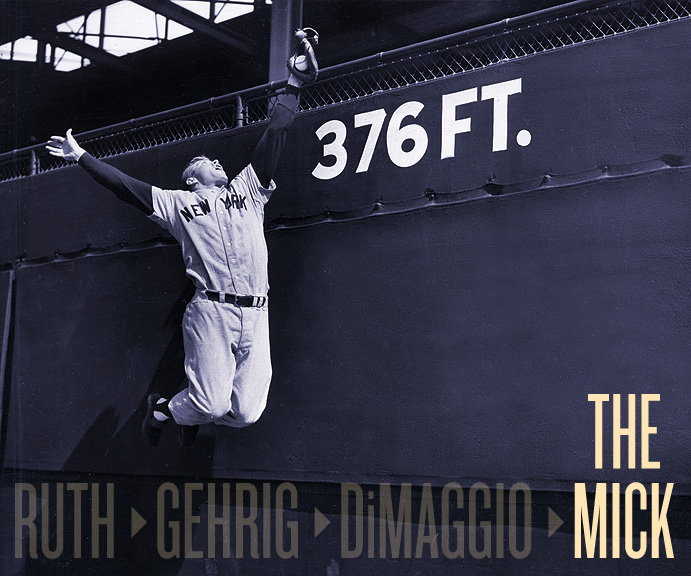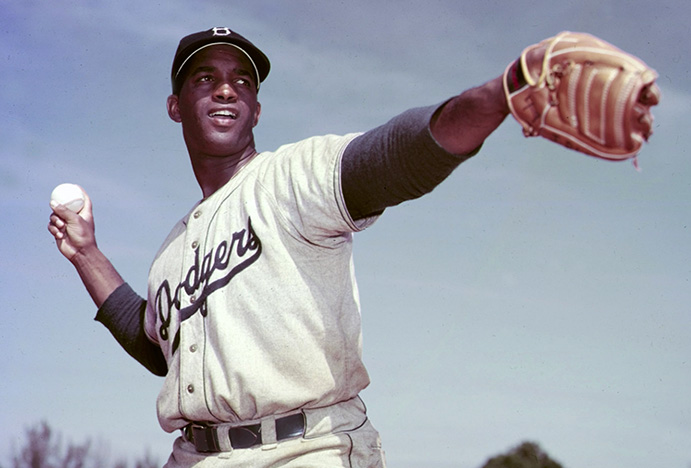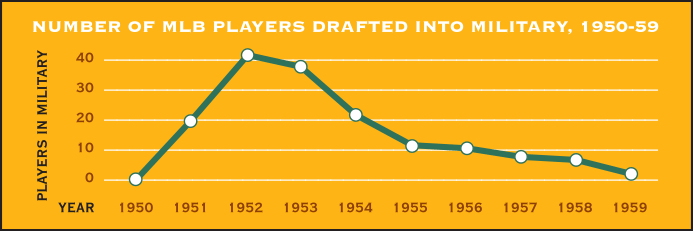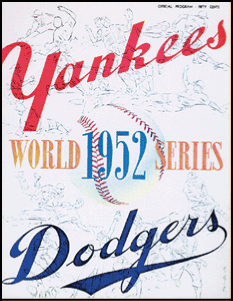THE YEARLY READER
1952: The Education of Mickey Mantle
The starry-eyed, 20-year-old propsect plays his first full season in the place of retired legend Joe DiMaggio and helps lift the New York Yankees to their fourth straight World Series victory.

Mickey Mantle was considered the next link in the legendary line of New York Yankee superstars—but he rode a turbulent path toward fulfilling the promise. (The Rucker Archive)
In the Summer of 1951, 19-year-old Mickey Charles Mantle wanted to quit the game of baseball and go home to Oklahoma.
The promise of superstardom as a New York Yankee seemed to drain into obscurity, from where Mantle had started his quest just two years earlier. The fast track to greatness—the tearing apart of minor league pitching, the power-packed .400 average at Yankee spring training highlighted by a 660-foot home run, an Opening Day assignment hitting third for the Bronx Bombers—had all become a distant memory, clouded by a plummeting average, a sackful of strikeouts and a demotion to the minors where he desperately resorted to laying down bunts just to get on base.
Mantle’s dad, Charles “Mutt” Mantle, gave him two options: Go home and become a miner, or get your head back on straight and play crackerjack baseball.
Less than a year later, as his father lay on his deathbed with Hodgkin’s Disease, Mantle had put his detoured career firmly back in focus, returning fear to the eyes of major league pitchers while preparing to extend the lineage of Yankee icons. As Lou Gehrig took the torch from Babe Ruth, as Joe DiMaggio took it from Gehrig, Mickey Mantle was now ready to take it from DiMaggio.
When the 1952 season began, it appeared that the Yankees were ripe for the taking. Sure, they were three-time defending world champions, but as it always seemed with manager Casey Stengel, the job was done using mirrors. And now many believed the mirrors were starting to crack. DiMaggio had retired. Johnny Mize, another future Hall of Famer, had become bench scrap at age 39. And the U.S. military—once again increasing its grip on baseball talent as the Korean conflict intensified—took away starting infielders Jerry Coleman and Bobby Brown, promising pitcher Tom Morgan and, for a second straight year, young pitching phenom Whitey Ford.
Until Mickey Mantle could fulfill the immense expectations branded upon him, the Yankees would have to do with a cast of good supporting players—but no stars.
The year before, Mantle’s performance was a little bit of everything—careening from cold to ice cold, to the minors and then back, finally warming into the resemblance of the threat many had hoped he’d become. At 19, the blonde-haired Oklahoman with All-American looks finished the regular season batting .267 with 13 home runs and 65 runs batted in over 96 games. But his first taste of the World Series ended painfully early; chasing a fly ball in Game Two against the New York Giants, he badly damaged his right knee when his spikes got caught in an outfield drain cover.
In a horrible irony, Mantle’s father collapsed while attempting to help bring Mickey to the hospital following the game. It was the beginning of Mutt’s troubles with Hodgkin’s, an illness that would take his life in May 1952 at the age of 40.
Mantle said that before his father’s death, baseball was a game. Now it was a profession, and his focus intensified into a business-like manner for which he would take a step closer to that expected idolatry.
Despite the presence of an improved Mantle, the Yankees played mortally through the first two months of the 1952 season, struggling to stay above the .500 mark. But no other American League team was dominating and the Yankees stayed within reach, allowing time for some of the newer talent outside of Mantle to help gel the team back into winning shape—including the young, pugnacious Billy Martin replacing Coleman at second base, and veteran pitcher Johnny Sain filling the void for injured starter Ed Lopat.
The call to rebound was answered and the Yankees claimed first place for much of the summer. But September held a major challenge: Up 3.5 games over the Cleveland Indians, New York was scheduled to play 18 of its final 21 games on the road—while the Indians had only two of their final 22 away from home.
The Indians went 18-4 over this stretch to do their part. Unfortunately for Cleveland, the Yankees did theirs as well, going 16-5 to hold off the Indians and take their fourth straight AL pennant by two games.
Though the Yankees got top performances from Yogi Berra (who held team highs with 30 homers and 98 RBIs) and 37-year-old right-hander Allie Reynolds (a 20-8 record and league-best 2.06 earned run average), Mantle was the key. His numbers were not the glamorous kind to be seen in later years, but his total productivity helped to place him at the top of the charts in batting average (third in the AL at .311), on-base percentage (third at .394) and slugging percentage (second at .530). Such output from a 20-year old was enough for the other AL teams to recoil in frustration at the continuing, ever-cyclical succession of Yankee legends.
By the numbers, the Indians looked to have the stronger team, thanks to league leaders Larry Doby (32 home runs), Al Rosen (105 RBIs) and three starting pitchers—Early Wynn, Mike Garcia and Bob Lemon—who each won at least 22 games. Surprisingly, the one major failing that likely cost the Indians an AL pennant was Bob Feller—who for the first time in his career lost it, finishing at 9-13 with a 4.74 ERA that was the worst among AL starters.

The majors’ most effective reliever in 1952, Brooklyn rookie Joe Black was surprisingly made the ace in the World Series by starting three games against the Yankees—pitching admirably each time but losing twice. (Associated Press)
Unlike the Yankees in the AL, the Brooklyn Dodgers continued to have the All-Star weaponry to scare the National League competition into submission. But they lacked Stengel’s mirrors to successfully take the next step. Haunted by the pennant race heartbreaks of autumns past, the Dodgers were on a mission to put a million miles between themselves and the rest of the senior circuit and stick the pennant in their back pocket with time to spare.
But as the Dodgers shot out of the gate as planned, so did the New York Giants—the team that gave the Dodgers nightmares through the offseason in the aftermath of Bobby Thomson’s dance with history. At the end of May, the Giants had won 26 of their first 34 games and looked ready to lock into a titanic duel with their Flatbush neighbors. That’s when the military came knocking at the Giants’ door—looking for Willie Mays.
Though Mays was batting .236 to start his second season, his departure to Korea—compounded by the extended loss of Monte Irvin to a broken ankle—was thought to be a blow to the Giants’ chances. Tough luck, sang the Dodgers, who were already making do without a star of their own—ace pitcher Don Newcombe—also drafted by the military.
Without Mays, the Giants sputtered for a month, springing the Dodgers well into first place. Particularly cleaning up against the second division teams, the Dodgers spent the summer missing nary a beat—even without Newcombe. His absence was eased by yet another African-American Dodgers prospect, the aptly named Joe Black. A rookie at 28, Black quickly emerged as the Dodgers’ ace reliever by winning 15 games (against four losses), saving another 15 and producing a 2.15 ERA that barely missed qualifying for the league lead. Opponents batted just .201 off the right-hander.
BTW: Brooklyn sported a combined 67-20 record against Boston, Chicago, Cincinnati and Pittsburgh.
Drafted
It wasn’t like 10 years earlier, when baseball scrambled and scratched for whatever talent they could find during World War II, but the Korean War still was successful in making a dent in major league rosters, peaking in 1952.

The Dodgers developed a tormenting case of déjà vu when, at the beginning of September, a nine-game lead over the Giants was quickly pared to three in just 12 days. The eerie parallels to 1951 would be short-lived, however, as the Dodgers this time held steady over New York for the final three weeks, sparing the drama of a nail-biting finish. It was, in fact, the first time in five years that the NL pennant would not be decided on the last day of the season.
Joe Black had gotten the call to start for the Brooklyn Dodgers only twice during the regular season, but now he was asked to open the World Series against the Yankees. It would be the first of three starts for Black in the Series, and it initially looked like the right strategy by Dodgers manager Chuck Dressen. In Game One, Black outdueled Allie Reynolds and went the distance, supported by home runs from Jackie Robinson, Duke Snider and Pee Wee Reese to win, 4-2. After the teams split the next two games, Black came back to the mound—as did Reynolds—on two days’ rest to start Game Four. Black was stellar once more—allowing just a solo shot by Johnny Mize in seven innings—but received no support, as Reynolds clamped down on the Dodgers by allowing four hits and striking out 10 in a 2-0 win.
BTW: Black’s Game One triumph was the first by an African-American in the World Series.
Brooklyn starter Carl Erskine provided perhaps the Series’ most eye-opening performance in Game Five. Trampled on for five runs in the fifth inning, highlighted by Mize’s third Series home run, Erskine regrouped and had enough gas left to retire the next 19 Yankees, as the Dodgers fought back and won 6-5 in 11 innings. Brooklyn was salivating over the prospects of its first ever world title; the Dodgers were leading the Series three games to two, with Games Six and Seven set for home turf at Ebbets Field.
BTW: Mize’s three World Series homers came after hitting just four for the entire regular season.
Mickey Mantle, who had watched most of the 1951 World Series from his hospital bed, was now ready to be front and center with his clutch game. His eighth-inning solo shot in Game Six, extending the Yankees’ lead to 3-1, was tabbed as insurance—which paid off as New York held off late Brooklyn rallies to win, 3-2.

The cover for the 1952 World Series program between the Yankees and the Dodgers.
Casey Stengel brought in left-handed reliever Bob Kuzava, who retired the left-handed-hitting Snider on a pop-up; when Robinson also popped one up in the infield, the formality of ending the inning quickly grew to alarm as the entire Yankee infield appeared apprehensive—except second baseman Billy Martin, who had perhaps the worst position on the ball. He nevertheless came racing in full tilt from the edge of the outfield to alongside the mound, making a running, knee-high catch to save the day. Kuzava stayed in for the final two innings and quietly put away the Dodgers to win it all.
The Dodgers’ sixth World Series loss in six tries was clinched with a paltry .215 team batting average—further burdened by slugger Gil Hodges’ 0-for-21 performance. The Yankees hit only a shade better, at .216—but exhibited much more pop.
The Yankees certainly would not have made it four championships in a row without Mickey Mantle’s help. Improving on his regular season play, Mantle batted .345 with a double, triple and two home runs—the first two of an eventual record 18 career World Series blasts for the Mick.
Mantle returned back to Commerce, Oklahoma, not as a failure but as a hero. A post-World Series parade given in his honor drew three times the town’s population. For a guy who wanted to chuck away his career little more than a year earlier, this was not a bad ascension.
And the New York Yankees couldn’t have been any happier about it.
 Forward to 1953: Brave New World After 50 years of geographical entrenchment, baseball begins an active era of relocation and makes Milwaukee its first benefactor.
Forward to 1953: Brave New World After 50 years of geographical entrenchment, baseball begins an active era of relocation and makes Milwaukee its first benefactor.
 Back to 1951: The Shot Heard ‘Round the World Bobby Thomson’s historic home run caps one of baseball’s greatest pennant races for the New York Giants.
Back to 1951: The Shot Heard ‘Round the World Bobby Thomson’s historic home run caps one of baseball’s greatest pennant races for the New York Giants.
 1952 Leaders & Honors Our list of baseball’s top 10 hitters and pitchers in both the American League and National League for the 1952 baseball season, as well as the awards and honors given to the game’s top achievers of the year.
1952 Leaders & Honors Our list of baseball’s top 10 hitters and pitchers in both the American League and National League for the 1952 baseball season, as well as the awards and honors given to the game’s top achievers of the year.
 The 1950s: A Monopoly of Success Though described as a golden age for baseball, most major league teams find themselves struggling—unless you’re in New York City, where the Yankees, Dodgers and Giants hog the World Series podium from 1950-56. But as the decade winds to a close, the euphoria of Big Apple baseball will rot overnight.
The 1950s: A Monopoly of Success Though described as a golden age for baseball, most major league teams find themselves struggling—unless you’re in New York City, where the Yankees, Dodgers and Giants hog the World Series podium from 1950-56. But as the decade winds to a close, the euphoria of Big Apple baseball will rot overnight.


 An extended interview with former pitcher Virgil Trucks, a good ‘ol boy from the South remembered for tossing two no-hitters while going 5-19 in 1952.
An extended interview with former pitcher Virgil Trucks, a good ‘ol boy from the South remembered for tossing two no-hitters while going 5-19 in 1952. Pitcher Duane Pillette talks of Bill Veeck and baseball’s most vertically-challenged player ever, Eddie Gaedel.
Pitcher Duane Pillette talks of Bill Veeck and baseball’s most vertically-challenged player ever, Eddie Gaedel.


